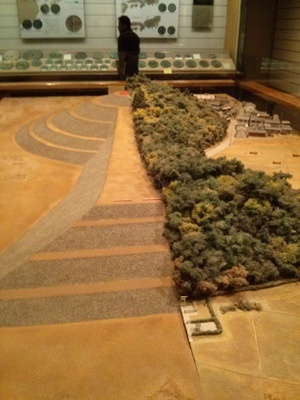Kofun Period

- Japanese: 古墳時代 (kofun jidai)
The Kofun period extends from roughly 250 CE to roughly 550 CE, and is marked by the prevalence of large tomb-mounds or tumuli, called kofun in Japanese, in which royalty and other elites were buried. The Kofun period and the Asuka period (538-710) which follow it together comprise the Yamato period, the period of time in which the people of Japan were divided into a multitude of regional polities, organized loosely under "Great Kings" based in the Yamato plain. Over the course of the period, this Yamato state first emerged, developed into a hegemonic centralized polity, gained in strength, and eventually grew into the proto-Japanese state.
The largest kofun are found in the Kinai region (in and around Nara, Kyoto, and Osaka), but roughly 150,000 tomb-mounds of various sizes are strewn throughout most of the main three islands of the archipelago (excluding Hokkaidô and the Ryûkyû Islands)
Bronze mirrors, symbols of wealth, power, and prestige held by local and regional elites, though largely imported in the Yayoi period, now began to be more widely produced within Japan.[1] By the end of this period, bronze items had largely lost their centrality and prominence as ritual objects and symbols of power; this shift took place earliest in Izumo province.[2]
Villages of the period often consisted of a combination of sunken pit houses and above-ground homes, along with elevated rice storage huts and other secondary buildings, surrounded by fences. They were often as small as being home to only three to five households. Paths less than a meter in width separated one house from another, and generally villagers are believed to have lived rather communal, collectively supportive, lifestyles. Some of the chief foods included rice, wheat, beans, and gourds, and people raised horses for use in the fields.[3]
An example of an elite's mansion from the period shows a fenced-in area surrounded by a considerable moat, and divided into ceremonial and everyday living areas. Some form of water pipes were used to bring in fresh water for ceremonial purposes. Meanwhile, the section in which the elite household lived included the main residence, storehouses, stables, and the homes of followers or retainers; the latter often taking the form of sunken pit dwellings.[4]
Though the end of the political and cultural circumstances of the Kofun Period, and the termination of the construction of kofun, cannot be pegged to a specific date or event, historians often cite the introduction of Buddhism in or around 538 as marking the end of the Kofun Period and the beginning of the Asuka Period, a period when the adoption of numerous Tang Dynasty political, legal, and cultural elements set the foundation for the heavily Chinese-influenced classical/traditional "Japanese" culture and state that would continue to develop over many centuries, down to today.
| Previous Period Yayoi Period |
Kofun Period | Following Period Asuka Period |
References
- Conrad Schirokauer, David Lurie, and Suzanne Gay, A Brief History of Japanese Civilization, Wadsworth Cengage (2013), 11-15.
- ↑ Gallery labels, "Mirrors," Japan Gallery, British Museum.
- ↑ Gallery labels, "Izumo and Yamato," special exhibit, Tokyo National Museum, Feb 2020.
- ↑ "Tôkoku no mura," gallery label, National Museum of Japanese History.[1]
- ↑ "Tôkoku no gôzoku kyokan," gallery label, National Museum of Japanese History.[2]